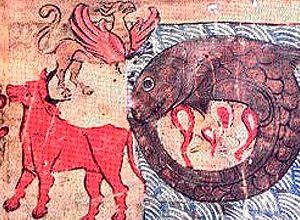
Responding to Bob’s post on the Leviathan symbolism in the Bible:
Yes, and Alter, in the same essay, says that Leviathan is confined to the “cage” of Job, Isaiah, and the Psalms, as if these were minor books of the Bible and the imagery was in some kind of quarantine from the rest of the biblical story.
For Frye’s take on Blake’s use of the Leviathan symbolism, It is worth reading Clayton Chrusch’s summary of chapter five of Fearful Symmetry. Here is an excerpt concerning the cluster of imagery attached to Satan and the serpent:
Alter is an excellent example of a militantly centrifugal critic, a normative realist or descriptivist. He puts all his intellectual energy into directing the verbal traffic of the Bible and literature outside, a critical cop breaking up any gathering of images. OK, move along now, disperse. The ideological underpinnings are worth noting: there is nothing but an objective dimension to reality, this is the way things are: obey and work.
” The serpent, actually, takes a number of symbolic forms: a Satanic form that tempts Adam, an Adamic form representing fallen humanity, and a Messianic or revolutionary form, where it is nailed to the tree of mystery as Orc, representing death and rebirth. The serpent also has a Chaotic form which is more sinister than its Satanic form. In this form, it manifests as a dragon ridden by Rahab or the Great Whore (Mystery), a Covering Cherub blocking the way to Eden, or as Leviathan. This symbolism means that the basis of all tyranny is chaos.”
That the basis of all tyranny is chaos may explain the title of Thomas Hobbe’s Leviathan: the idea that the only thing that can defend against the perceived chaos of life in a state of nature, which is also the perceived chaos of human nature, is a Leviathan-like political tyranny. Moby-Dick, as Frye has pointed out, is perhaps greatest example of Leviathan imagery in literature: Ahab projects a paranoid vision of chaotic nature and evil onto Moby Dick and creates at the same time, in his bloody hunt for the whale, an authoritarian system of tyranny aboard the Pequod.
It is true that one has to learn how to think archetypally as a critic, and one can simply refuse to learn, but that is to simply ignore the imaginative element in the act of reading any story or poem, and this critical position can easily take advantage of the fact that the imaginative element in reading literature takes place mostly on an unconscious level, precisely because it is a compressed skill we learn from childhood on.
Alter also dismisses out of hand Frye’s reading of the earth=mother/bride imagery in the second creation story: again, as Bob puts it, Frye has got biblical (and other) scholarship on his side, at least in the way in which creation myths are always versions, displacements, adaptations of competing mythologies, such as the agricultural myth of a symbolically female reproductive Nature. In this case, however, because we are dealing with a sexual myth of creation, female symbolism, and what Frye calls the patriarchal set-up and a “sexual neurosis,” the repression is greater and the displacement is all the more marked. Frye emancipates this imagery in his reading of the second creation myth in chapter six of Words with Power, in a way that is consistent with a feminist approach to scripture.
